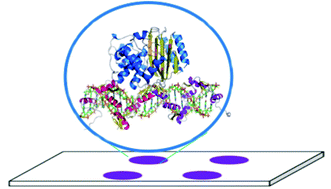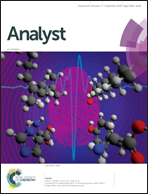Pathogen-specific DNA sensing with engineered zinc finger proteins immobilized on a polymer chip†
Abstract
A specific double-stranded DNA sensing system is of great interest for diagnostic and other biomedical applications. Zinc finger domains, which recognize double-stranded DNA, can be engineered to form custom DNA-binding proteins for the recognition of specific DNA sequences. As a proof of concept, a sequence-enabled reassembly of a TEM-1 β-lactamase system (SEER-LAC) was previously demonstrated to develop zinc finger protein (ZFP) arrays for the detection of a double-stranded bacterial DNA sequence. Here, we implemented the SEER-LAC system to demonstrate the direct detection of pathogen-specific DNA sequences present in E. coli O157:H7 on a lab-on-a-chip. ZFPs custom-designed to detect Shiga toxin in E. coli O157:H7 were immobilized on a cyclic olefin copolymer (COC) chip, which can function as a non-PCR based molecular diagnostic device. Pathogen-specific double-stranded DNA was directly detected by using engineered ZFPs immobilized on the COC chip with high specificity, providing a detection limit of 10 fmol of target DNA in a colorimetric assay. Therefore, in this study, we demonstrated the great potential of ZFP arrays on the COC chip for further development of a simple and novel lab-on-a-chip technology for the detection of pathogens.



 Please wait while we load your content...
Please wait while we load your content...
